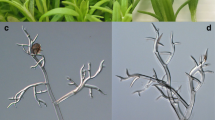Abstract
In August 2010, leaves of Ricinus communis with typical symptoms of powdery mildew were collected in south Khorasan province, eastern Iran. The pathogen was identified as the anamorphs of Leveillula taurica. This is the first report of a powdery mildew on Ricinus in Iran.
Similar content being viewed by others
The castor- oil plant (Ricinus communis) is an annual herb or spreading shrub to about 6 m tall that belongs to the Euphorbiaceae. It is perennial in moist areas and annual in seasonally frosty or dry areas. It has been cultivated in Asia and Africa from ancient times. This plant is now widely naturalized in moist tropical and subtropical zones of the world (Francis 2004).
During a survey of plant pathogens conducted on R. communis in August 2010, typical symptoms of a powdery mildew disease were observed on nearly 10% of the plants in the surveyed area in the Mahammadiah region (32° 52′ N/59° 13′ E), south Khorasan province, eastern Iran. Symptoms included extensive abaxial cover of older leaves by white patches of external superficial mycelium and conidiophores, along with chlorotic and necrotic regions on the upper leaf surface. Colonies were also present on the upper leaf surface (Fig. 1). These symptoms were mainly observed on castor- oil plants subjected to water deficiency stress, 2 weeks prior to harvest. However such symptoms were not observed in an ornamental castor- oil variety, planted close to the diseased plants. A sample was collected, dried and deposited in the herbarium at the Plant Pests and Diseases Research Institute (IRIPP) with voucher number IRAN 15030 F.
Fungal structures were detached from the diseased leaves of with a razor blade, mounted in water or lactic acid and examined with a light microscope.
Conidiophores emerged through leaf stomata, singly or branched, usually in groups of two to three, and formed dimorphic conidia (Fig. 2). Examination of 50 of each type of conidia yielded the following description of their morphology: primary conidia lanceolate with distinct apical points, 12.5–19 × 37.5–70 μm; secondary conidia cylindrical, 12.5–20 × 37.5–77.5 μm; both conidia hyaline with angular/reticulated wrinkling of the outer walls (Figs. 3 and 4). These morphological features are typical of the anamorphic stage description of Leveillula taurica (Lév.) Arnaud (Braun 1987).
Leveillula taurica has been reported on R. communis worldwide [Ramakrishnan and Narasimhalu (1941), Chiddarwar (1954), Amano (Hirata) (1986), Farr and Rossman (2010)] but this is the first report of this powdery mildew species on Ricinus communis in Iran (Ershad 2009; Khodaparast and Abbasi 2009). Other recent records of L. taurica from Iran were published by Mirzaee et al. (2007) and Mirzaee and Mohammadi (2010).
References
Amano (Hirata) K (1986) Host range and geographical distribution of the powdery mildew fungi. Japan Scientific Society Press, Tokyo, p 742
Braun U (1987) A monograph of the erysiphaceae (powdery mildews). Beiheftezur. Nowa Hedwigia 89:1–700
Chiddarwar PP (1954) Occurance of Oidiopsis taurica (Lev.) Salmon on a new host, Ricinus Communis L. Curr Sci 23:198
Ershad D (2009) Fungi of Iran, 2nd edn. Agricultural Research, Education and Extension Organization, Tehran
Farr DF, Rossman AY (2010) Fungal databases, systematic mycology and microbiology laboratory, ARS, USDA. Retrieved 30th December 2010, from http://nt.ars-grin.gov/fungaldatabases
Francis JK (2004) Ricinus communis L. Castor bean. In: Francis JK (ed.), Wildland shrubs of the United States and its territories: thamnic descriptions. San Juan, Puerto Rico and Fort Collins, CO: U.S. Department of Agriculture, Forest Service, International Institute of Tropical Forestry and U.S. Department of Agriculture, Rocky Mountain Research Station; pp. 643–644. Available at http://www.fs.fed.us/global/iitf/pdf/shrubs/Ricinus%20communis.pdf
Khodaparast SA, Abbasi M (2009) Species, host range and geographical distribution of powdery mildew fungi (Ascomycota: Erysiphales) in Iran. Mycotaxon 108: 213–216. Available at http://staff.guilan.ac.ir/staff/users/khodaparastm/fckeditor_repo/file/Checklist.pdf
Mirzaee MR, Abassi M, Nakhei A (2007) First report of powdery mildew on roselle caused by Leveillula taurica in Iran. Iran J Plant Pathol 43:478–479
Mirzaee MR, Mohammadi M (2010) Occurrence of powdery mildew caused by Leveillula taurica on onion (Allium cepa) in Iran. Plant Dis 94:280
Ramakrishnan TS, Narasimhalu IL (1941) A new host, Ricinus communis, for Leveillula taurica (Lev.) Arn. (Oidiopsis taurica (Lev.) Salm.). Curr Sci l0:211–212
Author information
Authors and Affiliations
Corresponding author
Rights and permissions
About this article
Cite this article
Mirzaee, M.R., Khodaparast, S.A., Mohseni, M. et al. First record of powdery mildew of castor- oil plant (Ricinus communis) caused by the anamorphic stage of Leveillula taurica in Iran. Australasian Plant Dis. Notes 6, 36–38 (2011). https://doi.org/10.1007/s13314-011-0013-y
Received:
Accepted:
Published:
Issue Date:
DOI: https://doi.org/10.1007/s13314-011-0013-y








